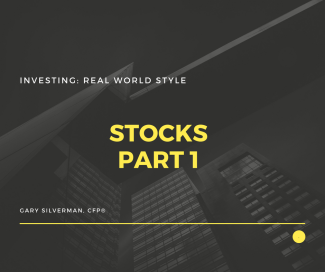
Investing with stocks: Part 1
By Gary Silverman, CFP®
In the past few months, my articles have focused on pre-investing tasks; those things you need to take care of before you start worrying about stocks, bonds, and mutual funds. We then looked at the importance of identifying how much risk your life (and therefore your portfolio) can stand. Today we begin a series dealing with the investments themselves.
We’ll start with stocks.
At my firm, when we build a portfolio for a recent college graduate starting her career, we buy stocks. When we build one for a middle-aged couple, we buy stocks. For the new retiree, stocks. And when we build a portfolio for an 80-year-old widow, we buy stocks (albeit, not that many). Compared to bonds or cash, stocks have given investors superior returns and are particularly important in growing assets faster than inflation and tax costs.
Over long time periods, stocks reflect the growth of business profit: profit that every business person strives for. Because of this, stocks are the asset class best suited to produce growth over the long-term. And since the previous examples included a retiree and a widow who have a good chance of living another 10 years, I need to make sure that part of their portfolio will grow fast enough to keep their purchasing power intact.
Being hesitant to invest in the stock market is a natural, cautious reaction to the fact that the stock market can go down (and often does so in a spectacular manner). That is why the percentage of a portfolio invested in stocks is as varied as the number of portfolios we manage. For some people it’s a clear majority; for others a minority.
A long time ago, well before I began giving investment advice, and even before I invested myself, I thought that investing only in stocks was a wise move. The logic was simple. The common investments of that time were stocks, bonds, and cash. Stocks gave the better return: stocks earned 10%, bonds around 6% and cash 3%.
Basing one’s investment philosophy on a single piece of data may be better than basing it on no data, but not by much. While those averages are still pretty much true, an average is, well, average. Those averages are based on multi-decade numbers. So indeed, if I had put my money into stocks when I was born and looked at the results now, I would be very pleased. My stock portfolio would have soared, greatly outdistancing itself from those containing only bonds or cash (or even gold).
But while that is correct, most of us know that the markets can turn against us at rather inconvenient times (like right before we were going to spend the money). So while my logic is sound, it is not complete. We’ll make it more complete next week.
This article was scheduled to be published in the Wichita Falls Times Record News on May 17, 2017.
Gary Silverman, CFP® is the founder of Personal Money Planning, LLC, a Wichita Falls retirement planning and investment management firm and author of Real World Investing.

